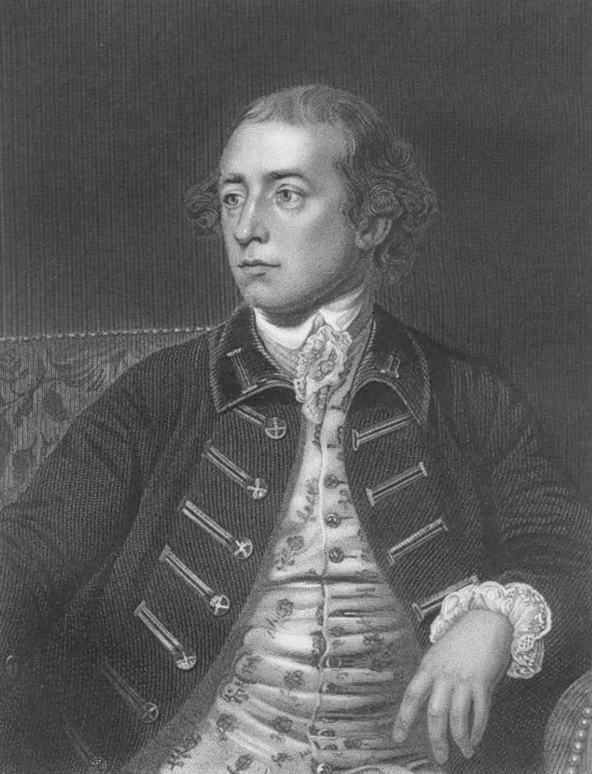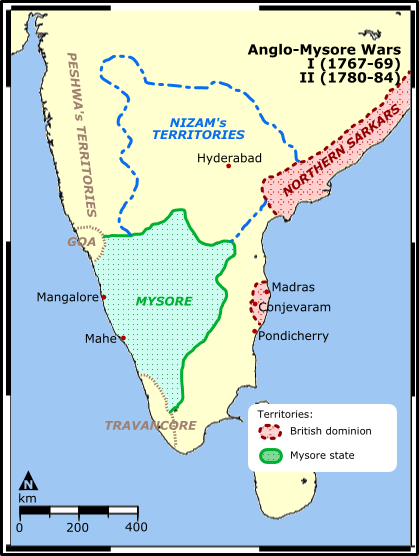|
Third Anglo-Mysore War
The Third Anglo-Mysore War (1790–1792) was a conflict in South India between the Kingdom of Mysore and the British East India Company, the Travancore, Kingdom of Travancore, the Maratha Empire, Maratha Confederacy, and the Nizam of Hyderabad. It was the third of four Anglo-Mysore Wars. Background Tipu Sultan, the ruler of the Kingdom of Mysore, and his father Hyder Ali before him, had previously fought twice with the forces of the British East India Company. The First Anglo-Mysore War, fought in the 1760s, had ended inconclusively on both sides, with treaty provisions including promises of mutual assistance in future conflicts. British failure to support Mysore in conflicts with the Maratha Empire, Maratha Confederacy and other actions supportive of Mysore's enemies led Hyder to develop a dislike for the British. After the British took the French-controlled port of Mahé, India, Mahé in 1779, Hyder, who had been receiving military supplies through that port and had placed ... [...More Info...] [...Related Items...] OR: [Wikipedia] [Google] [Baidu] |
Nizam Of Hyderabad
Nizam of Hyderabad was the title of the ruler of Hyderabad State ( part of the Indian state of Telangana, and the Kalyana-Karnataka region of Karnataka). ''Nizam'' is a shortened form of (; ), and was the title bestowed upon Asaf Jah I when he was appointed Viceroy of the Deccan by the Mughal emperor Farrukhsiyar. In addition to being the Mughal viceroy (''Naib'') of the Deccan, Asaf Jah I was also the premier courtier of the Mughal Empire until 1724, when he established an independent monarchy, realm based in Hyderabad, but in practice, continued to recognise the nominal authority of emperor. The Asaf Jahi dynasty was founded by Chin Qilich Khan (Asaf Jah I), who served as a ''Naib'' of the Deccan sultanates under the Mughal Empire from 1713 to 1721. He intermittently ruled the region after Emperor Aurangzeb's death in 1707. In 1724 Mughal control weakened, and Asaf Jah became virtually independent. The titular Nizams Battle of Palkhed, fought with the Marathas since the ... [...More Info...] [...Related Items...] OR: [Wikipedia] [Google] [Baidu] |
Commander-in-Chief, India
During the period of the Company and Crown rule in India, the Commander-in-Chief, India (often "Commander-in-Chief ''in'' or ''of'' India") was the supreme commander of the Indian Army from 1833 to 1947. The Commander-in-Chief and most of his staff were based at GHQ India, and liaised with the civilian Governor-General of India. Following the Partition of India in 1947 and the creation of the independent dominions of India and Pakistan, the post was abolished. It was briefly replaced by the position of Supreme Commander of India and Pakistan before the role was abolished in November 1948. Subsequently, the role of Commander-in-Chief was merged into the offices of the Commanders-in-Chief of the independent Indian Army and Pakistan Army, respectively, before becoming part of the office of the President of India from 1950 and of the Commander-in-Chief of the Pakistan Army from 1947. Prior to independence, the official residence was the Flagstaff House, which later became the ... [...More Info...] [...Related Items...] OR: [Wikipedia] [Google] [Baidu] |
Governor-General Of India
The governor-general of India (1833 to 1950, from 1858 to 1947 the viceroy and governor-general of India, commonly shortened to viceroy of India) was the representative of the monarch of the United Kingdom in their capacity as the emperor or empress of India and after Indian independence in 1947, the representative of the monarch of India. The office was created in 1773, with the title of governor-general of the Presidency of Fort William. The officer had direct control only over his presidency but supervised other East India Company officials in India. Complete authority over all of British territory in the Indian subcontinent was granted in 1833, and the official came to be known as the governor-general of India. In 1858, because of the Indian Rebellion the previous year, the territories and assets of the East India Company came under the direct control of the British Crown; as a consequence, company rule in India was succeeded by the British Raj. The governor-general ( ... [...More Info...] [...Related Items...] OR: [Wikipedia] [Google] [Baidu] |
Zamorin
The Samoothiri (Anglicised as Zamorin; Malayalam: , , Arabic: ''Sāmuri'', Portuguese: ''Samorim'', Dutch: ''Samorijn'', Chinese: ''Shamitihsi''Ma Huan's Ying-yai Sheng-lan: 'The Overall Survey of the Ocean's Shores' 433 Translated and Edited by J. V. G. Mills. Cambridge University Press for the Hakluyt Society (1970).) was the title of the erstwhile ruler and monarch of the Calicut kingdom in the South Malabar region of India. Originating from the former feudal kingdom of Nediyiruppu Swaroopam, the Samoothiris and their vassal kings from Nilambur Kovilakam established Calicut as one of the most important trading ports on the southwest coast of India. At the peak of their reign, they ruled over a region extending from Kozhikode Kollam to the forested borders of Panthalayini Kollam (Koyilandy).Varier, M. R. Raghava. "Documents of Investiture Ceremonies" in K. K. N. Kurup, Edit., "India's Naval Traditions". Northern Book Centre, New Delhi, 1997K. V. Krishna Iyer, ''Zamorin ... [...More Info...] [...Related Items...] OR: [Wikipedia] [Google] [Baidu] |
Mappila Muslims
Malabar Muslims or Muslim Mappilas are members of the Muslim community found predominantly in Kerala and the Lakshadweep islands in Southern India. The term Mappila (Ma-Pilla) is used to describe Malabar Muslims in Northern Kerala. Muslims share the common language of Malayalam with the other religious communities of Kerala.Miller, Roland. E., "Mappila" in "The Encyclopedia of Islam". Volume VI. E. J. Brill, Leiden. 198 pp. 458–56. According to some scholars, the Malabar Muslims are the oldest settled native Muslim community in South Asia. In general, a Muslim Mappila is a descendant of Hindu lower caste natives who converted to Islam.Hafiz Mohamad, N. P. "Socioeconomic determinants of the continuity of matrilocal family system among Mappila Muslims of Malabar" Unpublished Ph.D. thesis (2013) Department of History, University of Calicu/ref>P. P., Razak Abdul "Colonialism and community formation in Malabar: a study of Muslims of Malabar" Unpublished Ph.D. thesis (2013) Depart ... [...More Info...] [...Related Items...] OR: [Wikipedia] [Google] [Baidu] |
Ali Raja
The Sultan Ali Raja or Ali Raja or Adi Raja was the title of the Muslim Muslims () are people who adhere to Islam, a Monotheism, monotheistic religion belonging to the Abrahamic religions, Abrahamic tradition. They consider the Quran, the foundational religious text of Islam, to be the verbatim word of the God ... king of Arakkal kingdom from the sixteenth to early nineteenth century. Arakkal dynasty Reigning rajas and beevis * Ali Raja Ali I (1545–1591) * Ali Raja Abubakar I (1591–1607) * Ali Raja Abubakar II (1607–1610) * Ali Raja Muhammad Ali I (1610–1647) * Ali Raja Muhammad Ali II (1647–1655) * Ali Raja Qamal (1655–1656) * Ali Raja Muhammad Ali III (1656–1691) * Ali Raja Ali II (1691–1704) * Ali Raja Hamza I (1704–1720) * Ali Raja Muhammad Ali IV (1720–1728) * Ali Raja Beevi Harra Sultana (1728–1732) * Ali Raja Beevi Junuma Sultana I (1732–1745) * Ali Raja Kunhi Hamza II (1745–1777) * Ali Raja Beevi Junuma Sultana II (1777–1819) Heads of ... [...More Info...] [...Related Items...] OR: [Wikipedia] [Google] [Baidu] |
Warren Hastings
Warren Hastings (6 December 1732 – 22 August 1818) was a British colonial administrator, who served as the first governor of the Presidency of Fort William (Bengal), the head of the Supreme Council of Bengal, and so the first governor-general of Bengal in 1772–1785. He and Robert Clive are credited with laying the foundation of the British Empire in India. He was an energetic organizer and reformer. In 1779–1784 he led forces of the East India Company against a coalition of native states and the French. In the end, the well-organized British side held its own, while France lost influence in India. In 1787, he was accused of corruption and impeached, but he was eventually acquitted in 1795 after a long trial. He was made a privy councillor in 1814. Early life and education Warren Hastings was born in Churchill, Oxfordshire, in 1732 to Reverend Penyston Hastings and his wife Hester (née Warren), who died soon after he was born.Gloucestershire, England, Church of Engl ... [...More Info...] [...Related Items...] OR: [Wikipedia] [Google] [Baidu] |
Status Quo Ante Bellum
The term is a Latin phrase meaning 'the situation as it existed before the war'. The term was originally used in treaties to refer to the withdrawal of enemy troops and the restoration of prewar leadership. When used as such, it means that no side gains or loses any territorial, economic, or political rights. This contrasts with , where each side retains whatever territory and other property it holds at the end of the war. Historical examples An early example is the treaty that ended the Byzantine–Sasanian War of 602–628 between the Eastern Roman and the Sasanian Persian Empires. The Persians had occupied Asia Minor, Palestine and Egypt. After a successful Roman counteroffensive in Mesopotamia finally ended the war, the integrity of Rome's eastern frontier as it was prior to 602 was fully restored. Both empires were exhausted after this war, and neither was ready to defend itself when the armies of Islam emerged from Arabia in 632. Another example is the sixteenth-cent ... [...More Info...] [...Related Items...] OR: [Wikipedia] [Google] [Baidu] |
Treaty Of Mangalore
The Treaty of Mangalore was signed between Tipu Sultan and the British East India Company on 11 March 1784. It was signed in Mangaluru and brought an end to the Second Anglo-Mysore War. Background Hyder Ali became dalwai Dalavayi of Mysore by force in 1761 displacing the Wodeyar Dynasty which had previously ruled the Kingdom. In 1766, war with the British broke out and Hyder's forces came close to capturing Madras, before his attacks began to falter. The war ended three years later with the Treaty of Madras in April 1769. This provided the mutual restoration of all conquests as well as mutual aid and alliance in a defensive war. The Second Anglo-Mysore war broke out for a number reasons, primary among them being that Hyder Ali considered the British in breach of the treaty of April 1769 since they provided no aid in Mysore's defensive war with the Marathas. War with the British broke out in 1780 when Hyder led 80,000-90,000 men into the Carnatic region burning and destroyi ... [...More Info...] [...Related Items...] OR: [Wikipedia] [Google] [Baidu] |
Second Anglo-Mysore War
The Second Anglo-Mysore War was a conflict between the Kingdom of Mysore and the British East India Company from 1780 to 1784. At the time, Mysore was a key French ally in India, and the conflict between Britain against the French and Dutch in the American Revolutionary War influenced Anglo-Mysorean hostilities in India. The great majority of soldiers on the company side were raised, trained, paid and commanded by the company, not the British government. However, the company's operations were also bolstered by Crown troops sent from Great Britain, and by troops from Hanover, which was also ruled by Great Britain's King George III. Following the British seizure of the French port of Mahé in 1779, Mysorean ruler Hyder Ali opened hostilities against the British in 1780, with significant success in early campaigns. As the war progressed, the British recovered some territorial losses. Both France and Britain sent troops and naval squadrons from Europe to assist in the war effort, w ... [...More Info...] [...Related Items...] OR: [Wikipedia] [Google] [Baidu] |




